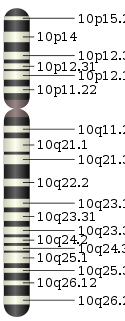- Chromosome 10 (human)
-
Chromosome 10 is one of the 23 pairs of chromosomes in humans. People normally have two copies of this chromosome. Chromosome 10 spans about 135 million base pairs (the building material of DNA) and represents between 4 and 4.5 percent of the total DNA in cells.
Identifying genes on each chromosome is an active area of genetic research. Because researchers use different approaches to predict the number of genes on each chromosome, the estimated number of genes varies. Chromosome 10 likely contains between 800 and 1,200 genes.[1]
Genes
The following are some of the genes located on chromosome 10:
- ALOX5: Arachidonate 5-Lipoxygenase (processes essential fatty acids to leukotrienes, which are important agents in the inflammatory response; also facilitates development and maintenance of cancer stem cells, slow-dividing cells thought to give rise to a variety of cancers, including leukemia);
- CDH23: cadherin-like 23
- CXCL12: chemokine (C-X-C motif) ligand 12, SDF-1, scyb12
- EGR2: early growth response 2 (Krox-20 homolog, Drosophila)
- ERCC6: excision repair cross-complementing rodent repair deficiency, complementation group 6
- FGFR2: fibroblast growth factor receptor 2 (bacteria-expressed kinase, keratinocyte growth factor receptor, craniofacial dysostosis 1, Crouzon syndrome, Pfeiffer syndrome, Jackson-Weiss syndrome)
- PCBD1: 6-pyruvoyl-tetrahydropterin synthase/dimerization cofactor of hepatocyte nuclear factor 1 alpha (TCF1)
- PCDH15: protocadherin 15
- PTEN gene: phosphatase and tensin homolog (mutated in multiple advanced cancers 1)
- RET: ret proto-oncogene (multiple endocrine neoplasia and medullary thyroid carcinoma 1, Hirschsprung disease)
- UROS: uroporphyrinogen III synthase (congenital erythropoietic porphyria)
Diseases & disorders
The following diseases are some of those related to genes on chromosome 10:
- Apert syndrome
- Beare-Stevenson cutis gyrata syndrome
- Charcot-Marie-Tooth disease
- Charcot-Marie-Tooth disease, type 1
- Charcot-Marie-Tooth disease, type 4
- Cockayne syndrome
- congenital erythropoietic porphyria
- Cowden syndrome
- Crouzon syndrome
- Hirschprung disease
- Jackson-Weiss syndrome
- multiple endocrine neoplasia type 2
- nonsyndromic deafness
- nonsyndromic deafness, autosomal recessive
- Pfeiffer syndrome
- porphyria
- tetrahydrobiopterin deficiency
- Thiel-Behnke corneal dystrophy
- Usher syndrome
- Usher syndrome type I
- Wolman syndrome
References
- Deloukas P, Earthrowl ME, Grafham DV, Rubenfield M, French L, Steward CA, Sims SK, Jones MC, Searle S, Scott C, Howe K, Hunt SE, Andrews TD, Gilbert JG, Swarbreck D, Ashurst JL, Taylor A, Battles J, Bird CP, Ainscough R, Almeida JP, Ashwell RI, Ambrose KD, Babbage AK, Bagguley CL, Bailey J, Banerjee R, Bates K, Beasley H, Bray-Allen S, Brown AJ, Brown JY, Burford DC, Burrill W, Burton J, Cahill P, Camire D, Carter NP, Chapman JC, Clark SY, Clarke G, Clee CM, Clegg S, Corby N, Coulson A, Dhami P, Dutta I, Dunn M, Faulkner L, Frankish A, Frankland JA, Garner P, Garnett J, Gribble S, Griffiths C, Grocock R, Gustafson E, Hammond S, Harley JL, Hart E, Heath PD, Ho TP, Hopkins B, Horne J, Howden PJ, Huckle E, Hynds C, Johnson C, Johnson D, Kana A, Kay M, Kimberley AM, Kershaw JK, Kokkinaki M, Laird GK, Lawlor S, Lee HM, Leongamornlert DA, Laird G, Lloyd C, Lloyd DM, Loveland J, Lovell J, McLaren S, McLay KE, McMurray A, Mashreghi-Mohammadi M, Matthews L, Milne S, Nickerson T, Nguyen M, Overton-Larty E, Palmer SA, Pearce AV, Peck AI, Pelan S, Phillimore B, Porter K, Rice CM, Rogosin A, Ross MT, Sarafidou T, Sehra HK, Shownkeen R, Skuce CD, Smith M, Standring L, Sycamore N, Tester J, Thorpe A, Torcasso W, Tracey A, Tromans A, Tsolas J, Wall M, Walsh J, Wang H, Weinstock K, West AP, Willey DL, Whitehead SL, Wilming L, Wray PW, Young L, Chen Y, Lovering RC, Moschonas NK, Siebert R, Fechtel K, Bentley D, Durbin R, Hubbard T, Doucette-Stamm L, Beck S, Smith DR, Rogers J (2004). "The DNA sequence and comparative analysis of human chromosome 10". Nature 429 (6990): 375–81. doi:10.1038/nature02462. PMID 15164054.
- Deloukas P, French L, Meitinger T, Moschonas NK (2000). "Report of the third international workshop on human chromosome 10 mapping and sequencing 1999". Cytogenet Cell Genet 90 (1–2): 1–12. doi:10.1159/000015653. PMID 11060438.
- Gilbert F (2001). "Chromosome 10". Genet Test 5 (1): 69–82. doi:10.1089/109065701750168824. PMID 11336406.
Human chromosomes Autosome Sex chromosome Categories:- Genetics stubs
- Chromosomes
Wikimedia Foundation. 2010.

